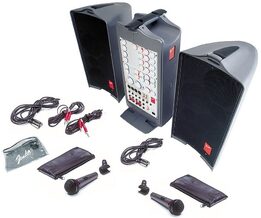Sometimes we are forced to settle for only two channels of audio in our software or in our presentation. Some academic versions of popular audio editing programs limit the user to only two master outputs, as opposed to the full priced versions that support 5.1, 7.1, or complete 360 immersive.
When editing with software that limits me to only two finalized tracks, my strategy has always been to only complete the audio editing up to the point of building stems or aux tracks, but not to the point of doing any sort of master mixdown. Save your project (with all linked media) as a work in progress, and then plan on doing your final mix somewhere else, better equipped acoustically as well as with full versions of the software, including the latest noise reduction, FX plug-ins, and broadcast standards.
But even if I had access to the higher end software, I still would not attempt to finalize my mix in the home office. The size of the room, acoustics, and speaker quality are a far cry from an actual movie theater; nor do I have the years of specialized experience in mastering that the elite editors and re-recording mixers possess.
However, there are times and projects that do not warrant the Hollywood treatment. No one brags about them, but they often pay the bills.
Those projects do not play in dedicated movie theaters, but in conference center ballrooms, outdoor pavilions, and corporate board rooms. Screens are not 60 feet across, but more likely just several feet. Picture an 85-inch diagonal monitor, or a portable HD video projector on a typical portable roll-up screen.
What is the sound system during those presentations? We generally do not have quality decoders, a bank of amplifiers, and a ring of surround speakers. More likely, we are feeding a small video projector from a laptop – along with only two tracks of audio. The laptop in turn feeds a portable PA system, which is also most probably a stereo amp wired up to two or four outboard speakers on tripod stands!
So how to give the client a “big theater” immersive audio sense, using low budget A/V hardware?
The trick is to stop thinking horizontally and to start thinking and mixing vertically. Normal stereo is left to right. Stereo mics are made to provide left/right pickup. Pan controls on most portable mixing panels sweep left to right.
But when you are in the audience, staring at a relatively narrow screen that occupies only a fraction of your vision width – just how believable is a hard left or right sound? Probably more of a mental distraction than an enhancement of the viewing experience – considering that screen left and screen right are still pretty much centered in front of you.
Where is the viewer in terms of depth? We are looking through a spacial window. Objects are in front of us, but it is possible for them to travel to or from that window (rear to front or vice versa).
If we get used to a balanced left/right sound in front of us, and then it suddenly whooshes over and to the rear of us (or from the rear to forward) – it catches us unexpected. We think 3D or immersive.
Achieving this effect on a shoestring budget is remarkably simple. As you do your final mixdown at home, treat “left” as front, and “right” as rear. It might help to reposition your speakers in your edit bay.
When it comes time for the presentation, make sure that you have a minimum of four speakers to plug into your portable PA amp. Most of the field PA systems have enough jacks to feed at least four outboard speakers, if not more.
But do not place your speakers in the typical left/right arrangement on either side of the screen. Instead, place your LEFT speaker and AUX LEFT speaker flanking on both sides, near the front. Put your RIGHT and AUX RIGHT speakers at the back of the room, also on both sides.
Your audience will not hear left/right stereo, but they won’t miss it either, because of the relative small screen size and narrow seating arrangements. They will be impressed and surprised by front/back panning!
And if you are using stereo mics during production, try orienting them front/back rather than left/right. You will end up with sounds that will amaze.
